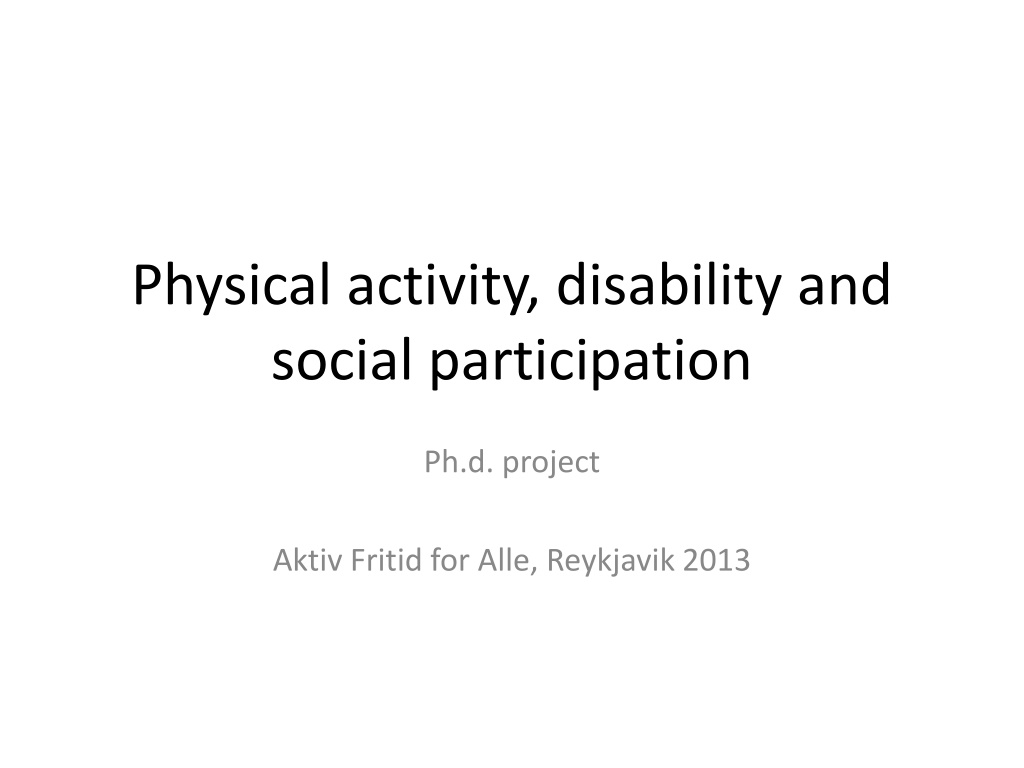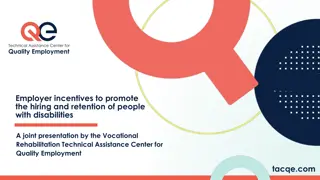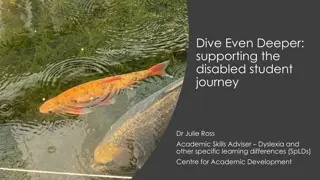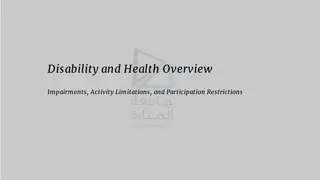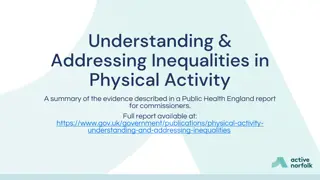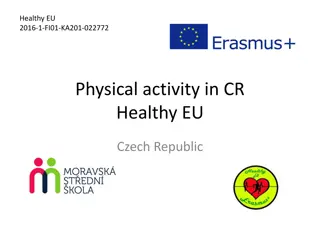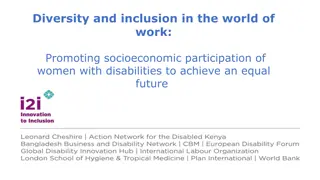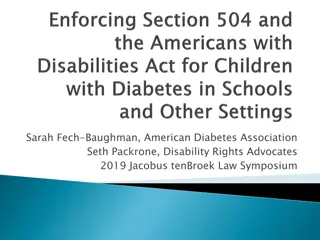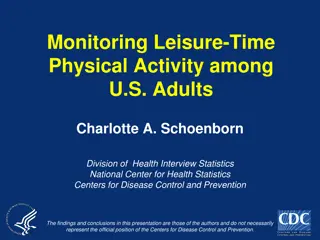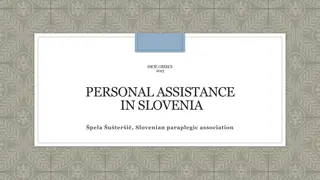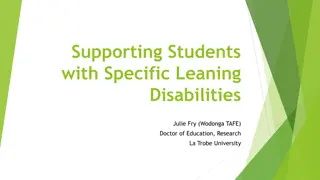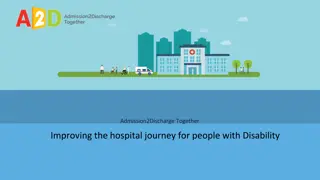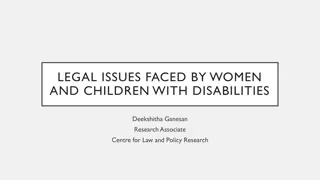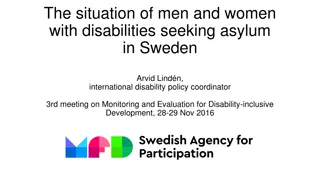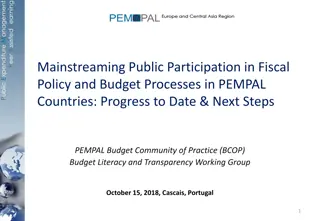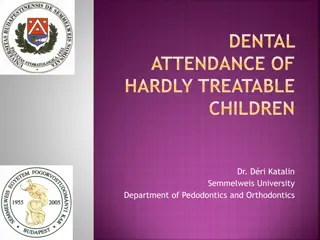Understanding Participation in Physical Activity among People with Disabilities
The Ph.D. project explores the relationship between engaging in physical activity and various aspects of everyday life for individuals with physical disabilities. It emphasizes the significance of participation in social practices and how it influences both subjective and objective experiences. The study showcases how involvement in physical activity extends beyond mere exercise, highlighting how it can enhance abilities that transcend into different contexts. Additionally, it discusses the societal readiness required to facilitate participation and the transformative nature of being active in the community for individuals with disabilities.
Download Presentation

Please find below an Image/Link to download the presentation.
The content on the website is provided AS IS for your information and personal use only. It may not be sold, licensed, or shared on other websites without obtaining consent from the author. Download presentation by click this link. If you encounter any issues during the download, it is possible that the publisher has removed the file from their server.
E N D
Presentation Transcript
Physical activity, disability and social participation Ph.d. project Aktiv Fritid for Alle, Reykjavik 2013
Theme of the project The theme of the project is the relation between participation in physical activity and other occurrences of everyday life of people with physical disabilities.
Participation Definition: Human action taking place under certain conditions, together with others in a social practise, in relation to a common cause. (Critical Phychology) Subjective as well as objective experience Relation between the individual and society
What does the study tell us? The athletes are active in many other contexts of society than only physical activity They take experience from one context to another also regarded through their life span Participation in one context encourage participation in other contexts The context of physical activity provides options to develop abilities which can be transformed into other contexts
Persons showing themselves as active people open doors while they become visible for others as a ressource in the community. Participation depends on the readiness of the social community to make an effort, so that the person can make use of his/her abilities in the actual context from his/her actual position in relation to the common cause. In physical activity he person may forget the body , thus directing awareness towards the surrounding world.
Research Questions How is the relation between participation in physical activity and everyday life of people with disabilities? How do people with a physical disability experience the significance / meaning of participating in physical activity in relation to their everyday life?
Background: Disability and participation People with disabilities participate to a lesser extend in society than other people Social network limited Feeling devaluated as human beings Internalise negative attitudes from society Barriers in society hinder participation in social communities Unimployed more often than not-disabled Few are members of leisure time activity clubs
Review of the literature No studies are found that directly investigate the experienced impact of participation in physical activity to the everyday life of people with physical disabilities. Most studies use interviews only, but this method seems not sufficient to elucidate the question We must also look into the practices of everyday life and do observations. Participation in physical activity and everyday life of people with physical disabilities: A review of the literature. Scandinavian Journal of Disability Research 2013.
Statistic correlation Telephone interview with 922 persons with various types of disabilities: Legs, arms, hands, vision, behaviour, intellect Questions about participation in physical activity on regular basis away from home.
Participation in PA 57, 3 % are physically active out of home one or more times a week. 27,7 % in ordinary sports club 28 % join a fitness centre 15,7 % participate in a municipality gym 4,2 % are members of at disability sports club, and 70,6 % state that they practise self organised physical activities. 42,7 % are not physically active
Particiaption in other social contexts Significant correlation between participation in physical activities on regular basis and employment, educational status, volunteerism, leisure time schooling membership in a disability organization. Kissow, A. & Singhammer,J. (2012).Participation in physical activity and everyday life of people with disabilities. European Journal of Adapted Physical Activity, 5(2). 65-81
Qualitative study - design Qualitative design to understand how things are connected i social praxis. Phenomenological hermeneutics as scientific framework Method created for the actual purpose: Searching to understand and find meaning, create thick data , sensitive to nuances and keeping close to the lived experience of the informants.
Informants 7 Persons with physical disabilities, age 25-53 All of them regularly participants in physical activities: Golf, sailing, swimming, horse-back riding, wheel-chair rugby, handbiking, wheel- chair hockey, scouting Various motives for and levels of participation
Method Narrative interviews: Please, tell me about your life with physical activities . Observations of selected situations of the persons everyday life including participation in physical activities. Scenic descriptions: As I see it. Schedule of a typical week for the person Photos of everyday occurences as a basis for further dialogue about the persons life world
Analysis Searching for signs in data that may lead to an understanding of the meaning of participating in physical activity in relation to everyday life Hermeneutic text analysis Across narratives and observations Theoretical reflection
Theory Theories are used to reflect over and unfold empiry Critical psychology (Holzkamp, Dreier) Body-phenomenologi (Merleau-Ponty, Leder) Learning as social practise (Lave & Wenger) Stigma (Goffman) og liminality (Murphy, Turner) The political body (Foucault)
Themes The body participating Being visible Social appreciation and respect Assisting others to participate Being active in society Physical abilities making participation possible
The body participating Constraints in the options of body-actions in relation to the external environment has less significance: As other persons in the social community give adequate support As adaptation of the context provides options for the body as it is. As tools are provides that may function as an extension of the body in activity
In that case the person seems to forget the body (Leder 1990) and experience the body as reaching out towards the environment. Thus the options of the person to participate fully in the actual social practise are enhanced. And he is able to offer his ressources to the community and develop his participation
Example: Scenic description Brian is alone in the boat. It s wonderful, he says, smiling. He has a tailwind and the speed is fairly good. He is sailing in zigzag showing that he is in control of winds and sails. Being in the boat his has no need for personal assistance. I m heading for the fiord, he states. I have a long way to go. Don t go too far out the coach says. Why not? That s why I m here, Brian claims boldly and sets the sail against the wind.
Narrative I learned sailing at a folk high school, when I was in my twenties. It was wonderful to be able to be in a sailing boat alone and be able to steer it myself. The instructor said: You re son of a skipper, you have to learn sailing . Then he pushed the boat and off I went! I had no other choice than to feel my way pulling the ropes. But after a while I actually figured out how to sail a mini 12er. There was a motor boat following me, looking after me a bit. I have been sailing since that time.
What may he learn that may change his life world? The body may participate even if it does not fit into the cultural norm of the body, because it is part of a social community providing room for the body as it is. He gets a counter-image to the conception that the body has to become normalised to participaet and to be productive.
Beeing visible Physically disabled people often feel ignored or invisible to other people. When they show up doing physical activity they feel thet they become visible to others in a positive way. The focus is directed towards their special abilities. Other people feel less uncomfortable by meeting the person because of his special competences.
Example: Narrative But people also view me differently if I come along on my bike compared to my wheelchair. If people pull themselves together and come up and manage to ask: Why are you in a wheelchair? , then I can answer. But when I come on my bike, then it s: Wow, that s a great bike! How fast can it go? How many gears has it got? I wish I had one like that , and so on and so forth. So in that case it s not mostly about the disability, it s the bike they ask about first. So then they have a different view and experience of me when I come on my bike instead of in a wheelchair. It s a very obvious difference. No matter where you go, there aren t many people who start talking to you when you re in a wheelchair. They turn the other way, or whatever.
Scenic description For his run today, he has planned a route out into the countryside. The first section is on a cycle path along a route into town. When he is driving there, one may notice how low he lies in his handbike, almost like in a go-cart. He is an obvious feature of the townscape, noticed by all who meet him. Some wave to him. Soon he turns left and cycles out of town.
What does he learn that may change his life world? You must be visible to develop participation. Other persons get courage to support his participation through help and appreciation. It is possible to move into a new social context.
Social appreciation and respect The informants experience, that other people react positively surprised and that they are attributed to higher status when they show themselves as physically active persons. Creates a counter image to the stereotype perception that they are inactive and in-capable Positive expectations from others and the person expecting himself that he is able to paticipate in vairous other contexts as well, seem facilitate social participation.
Example: Narrative It happens to me all the time that I meet other non-disabled people who ask: Are you in the Paralympics? Then I say: Oh, come on now! But I then I tell them that I play wheelchair rugby and what it is. And if you have a computer to hand and can go to the Internet and show video clips from websites or from YouTube or wherever they are, they are very impressed and find it quite amazing after all, what people can do.
A lot of people think, Well, hes sitting at home reading the paper he s a pensioner , or something or other. And when in fact I both have a job and do sport, well, it s like your social status improves.
But you know, bottom line, its got something to do with the fact that you re showing that you can do something. When you re capable of something, you also get a slightly higher status in society in general.
What does he learn that may change his life world? Demonstrating competecies in various contexts implies respect and positive expectations in the surroundings Opens space for participation in various social contexts so that the person gets the opportunity to contribute with his abilities and further develop his competencies As the person participates fully stigma is weakened and the persons power to act is enhanced
New perspectives for research in this From focus on the individual to focus on social communities. Social communities as spaces for development in rehabilitation: How do we make social communities into places where people with different conditons and abilities may develop participation together?
Articles published based on the results Participation in physical activity and everyday life of people with physical disabilities: A review of the literature. Scandinavian Journal of Disability Research, online 2. sept. 2013. Participation in physical activities and everyday life of people with disabilities. European Journal of Adapted Physical Activity 2012. 5(2), 65-81. Krop og funktionsh mning . I: Bonfils, I. S., Kirkeb k, B., Olsen, L. & Tetler, S. 2013. Handicapforst elser-mellem teori, erfaring og virkelighed. Copenhagen: Akademisk Forlag (Octobre 2013)
Thank you Anne-Merete Kissow ak@handivid.dk Danish Disability Sport Information Centre www.handivid.dk
